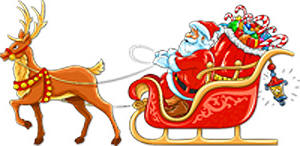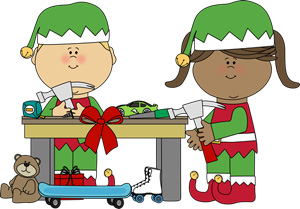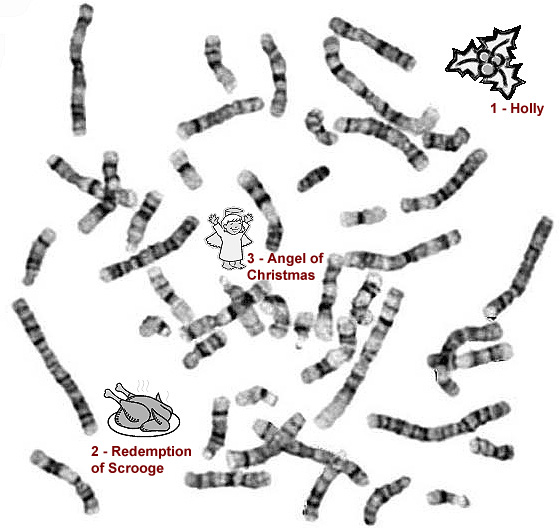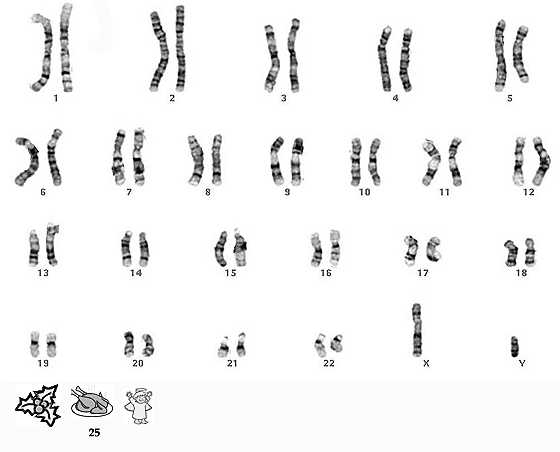The Genetics of Santa Claus
 Recent
research into Santa's chromosomal make-up has revealed somewhat
surprising evidence.
Recent
research into Santa's chromosomal make-up has revealed somewhat
surprising evidence.This branch of science received a gigantic boost when it was finally realised that instead of wasting time thinking about a sleigh breaking the sound barrier, why we don't hear sonic booms and how Santa can physically carry so many toys, that the more fruitful route was to investigate and discover the actual source of Christmas Magic.
This has met with some skepticism from a few sourpusses who enjoy disappointing small children with "hard facts". Ultimately we hope that they may come to understand the significance of Christmas Magic - gene therapy has been mooted for some of the more recalcitrant individuals.
As we all know, the DNA that carries the plan
to make an entire you is contained in the nucleus of each body
cell (trllions of them) and arranged in structures called chromosomes.
Chromosomes usually hang around in pairs and most people have
23 pairs.
Santa has a similar genetic make-up to everyone
else, except that he has 3 extra chromosomes - this is known
as Trisomy 25 - (for the 25th of December).
 These
extra chromosomes are uniquely shaped and can be easily identified
in a karyotype (picture of all the chromosomes) of Santa taken
from a hair follicle found besides the remains of a mince-pie
on December 24th 2011 (credit - Mr. Precious Mtungi from Old
Town, Mombasa, Kenya for spotting this).
These
extra chromosomes are uniquely shaped and can be easily identified
in a karyotype (picture of all the chromosomes) of Santa taken
from a hair follicle found besides the remains of a mince-pie
on December 24th 2011 (credit - Mr. Precious Mtungi from Old
Town, Mombasa, Kenya for spotting this).
The unusual
shape of the chromosomes is in large part responsible for Santa's
unique form of magic, especially the third chromosome.
Further evidence has come to light that shows that the reindeer
have one of these chromosome 25's (faecal sample found and analysed
quickly by a special fixation procedure in a mixture of egg
nog and punch (credit - Anuradha Patel, Nilambur, Kerala, India).
Finally another DNA sample derived from another hair follicle
found inside a hand-knitted woolly hat is thought to have come
from one of Santa's elves when he was trying it on after Mrs.
Claus had knitted it (credit - Brendan McNamara in Portnescully,
Co. Kerry, Ireland)
Thus the following picture has been assembled:
1/ The first of the chromosome 25's known as the "Holly Homolog" - it is curiously shaped akin to a holly leaf, with telomeres that increasingly resemble holly berries with age.
2/ The second form of chromosome 25 is known as the "Redemption of Scrooge Homolog" - it resembles, as some say a generously sized turkey, though any similarity is regarded by the scientific community as fanciful.
3/ The third and most mysterious of the three chromosome 25 homologues is called the "Angel of Christmas Homolog" - it is oddly formed, but of course doesn't look like the fairy on anybody's Christmas Tree, no siree bob, as that would be daft.

Santa's karyotype

Santa's karyotype arranged in homologous
pairs (and a magical three)
The Significance of the Chromosome 25 Homologues
1/ The "Holly Homolog" is thought to contain the basic magic of Christmas. That it is found in Santa's reindeer is almost beyond doubt - what other form of dung that is evaporating to glitter-dust before your eyes would you see on your roof on Christmas Eve?
It is also hypothesized to be found in Santa's
Elves and somewhat controversially in DNA that is thought to
also be found in Santa himself. "Well I saw this large jolly
man with a big white beard eating a mince pie as I was falling
asleep, he went "shhhh" and had a big bag of toys" - Gladys
Mtungi, aged 6 - Kenya.
2/ The second homolog, the
"Redemption of Scrooge Homolog" is thought to contain the
next level of Christmas magic, it also introduces the "human
element" to Christmas. Sometimes the chromosome is present and
sometimes it isn't depending on the mental attitude of the observer
of the karyotype - a simple thought of "bah humbug" is enough
to make the chromosome disappear when viewed with a standard
optical microscope.
3/ The third homolog, the "Angel
of Christmas" is as so far discovered, the most unusual
and rarest chromosome of all, probably eclipsing "Krypton Super",
which while only found on earth in Superman is thought to be
a common dominant on the yet unfound planet Krypton.
The Angel-of-Christmas is purported to be the location of such genes as:
-
Knows where all the kids in the world live
-
Knows whether or not you've eaten all your vegetables
-
Weren't me
- the latter being particularly enigmatic
and potentially surprising given Santa's usually conformist
proclivities.
The Angel-of-Christmas is what makes Santa
the man he is. The Redemption of Scrooge Homolog makes him a
particularly nice and generous guy and means that any scary
little elves in funny hats and shoes you meet are ultimately
ok.
The more basic Holly Homolog can be found in a range of species (Santa, elves, magical reindeer) and may well turn out to be a form of archaic DNA akin to that found in mitochondria - it may even have been a successful form of early genetic engineering by St. Nicholas.
So Where Lies the Future?
Santa and Christmas research is an especially unique branch of science.
Current research is focused on the hypotheses:
-
The nicer you are, the better your life is
-
It really is better to give than receive
-
Many a mickle maks a muckle
(sponsored by Mrs. Claus's Scottish Uncle Hamish)
Funding for this research is continually being sought and is somewhat unique as might be expected of the field. Good deeds and kindnesses especially by children and especially if the recipient is a stranger and deserving, boost funding in a sort of universal karma sort of way.
Keeping Christmas well also helps to boost the research as do being good, eating all your vegetables and not letting the Christmas sourpusses who "don't get it" from bothering anyone.
Warning - if anything on this page is congruent with the truth - it is either by accident rather than device or specifically for comedic effect - webmaster
